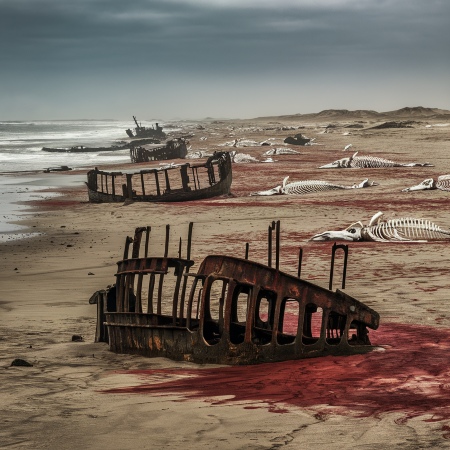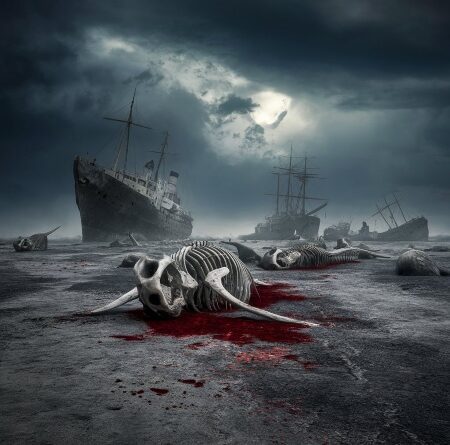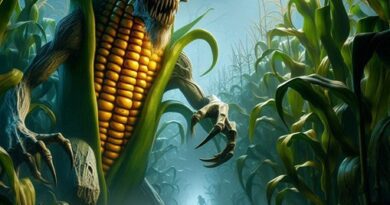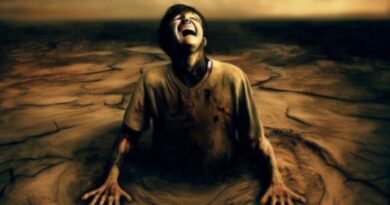Skeleton Coast Namibia Is A Cemetery Of Animals, Ships, And Myhts
In South West Africa, on the shores of the Atlantic Ocean, there is a republic called “Namibia.” The average person may only be able to memorize a few facts about the relatively new country, which only gained independence from South Africa in 1990. In our context, as part of the journey to find scary places on the globe, we definitely came across Namibia more than once. Not long ago, we wrote, for example, about Kolmanskop, the abandoned mining town that has become a place where the sand took over, outside the remaining houses and inside them.
The Skeleton Coast in Namibia, located in the area where the desert and the ocean meet, comes into the picture at exactly this point, as you can deduce from its name. The Skeleton Coast is a mysterious and exciting beach, which can also be seen as a triumphant testimony to the power of nature or even to the dangers it poses.
But what exactly are the skeletons that are hiding here (hint: not only what you think)? What is so scary about it today, and is it possible to visit here? And how does all this relate to one of the most popular series on television today?
Where Is The Skeleton Coast?
The Skeleton Coast is a 500-kilometer stretch of beach that lies along the Atlantic Ocean in the northern part of Namibia, from the north Kunene River to the Swakop River. The beach is located near the Namib desert – the vast desert considered one of the most notable and spectacular in the world. Please note that the term “Skeleton Beach” is sometimes used to refer to the entire coast of the Namib Desert, but we will stick with the more common definition, which relates only to the coastline.
The skeleton beach has relatively soft sand, exposing the rock in various places. Still, the topography changes depending on the specific area of the beach: in the south, you will find more gravel, while the north of the beach is wilder and includes giant sand dunes.
The leading visual beauty of Skeleton Coast Namibia is in the combination of the enormous dunes, the arid desert, and the sea with the rocky coast. Time has sometimes created unique shapes in the rocks, including colossal granite rocks.

Why Is Skeleton Coast Dangerous?
The main question you are probably asking is what exactly are those skeletons that gave the beach its nickname, alongside other and no less intriguing nicknames such as “the gates of hell” or “the land that God created in his anger.”
The simple answer is that the dangers here, and especially their results, have changed throughout history. In previous years, it was possible to find on Skeleton Coast Namibia many bones of marine animals – mainly whales and seals – which, unfortunately, were hunted by man and eventually washed up on the beach. In the past, large groups of hunter-gatherers lived here, responsible for these gloomy images.
And speaking of animals: although the conditions here are far from simple, today you will find marine animals that have adapted to them, for example, quite impressive colonies of seals on the Skeleton Coast Namibia. As a result of the location near the desert, animals also learned to survive in the rather extreme conditions here, relying on water wells they dug, fleshy plants full of water, and, of course, other unlucky animals as well. If you are lucky, you will come across here:
- Large colonies of seals
- Predators like Skeleton Coast lions, hyenas, and jackals
- Antelope species such as oryx and springbok
- Elephants that have learned to live in the unique conditions that prevail here
- A wide variety of birds, including rare species
The Skeleton Coast Shipwrecks
Today, the skeletons you will find here are of a different type. Along the beach, you will find more than 100 sailing vessels and ships, small and large, sticking out of the sand at various angles, reminiscent of giant bones. One of the most famous ships here is the “Eduard Bohlen,” a German steamship that sailed back in 1907 and could not survive the complex sailing conditions offered by the place. The large ship located today in the heart of the sand, about half a kilometer from the beach, stands out for its solitude. Besides, you will find other ships that arrived here, sometimes on purpose and sometimes by mistake, throughout history.
The name “Skeleton Beach” itself was coined by the writer John Henry Marsh. This name is the title of a book he wrote describing the plots of one of the ships that were wrecked here: the British cargo ship Dunedin Star, which ran aground in 1942. Although all 106 passengers and crew of the boat survived, the efforts claimed the lives of two of the lifeguards and destroyed a ship and an aircraft. The book was published in 1944, and since then, it has become associated with the beach. On most maps (and also on Google), you will find it listed only as “Skeleton Beach.”

According to reports, human bodies were also found here, silent testimony to the fact that behind every shipwreck, there is a crew who might not have survived the sinking. Lighthouses were built along the coast over the years, with the aim of warning the ships arriving here of the dangers. Most of the lighthouses are abandoned today, which adds a little more to the creepy atmosphere of the place.
Despite the horror stories, there are, of course, countless people who did get here and survived to tell the guys. One of them is the famous Portuguese explorer Diogo Cao, who explored the west coast of Africa in the 15th century. In the first voyage (1482-1483), he depicted, among other things, the Congo River, and in the second voyage (1486-1485), which is more relevant to our case, he explored Namibia, including the Skeleton Coast. To this day, you can find the stone pillars (“Padrão”) on the beach and in other places in Namibia, designed to define the Portuguese hold on the land instead of the wooden crosses used before.
One Beach, Many Hazards
As horror fans, you probably know that every skeleton – whether human, animal, shipwreck, or anything else – has its circumstances, some of which can be pretty terrifying. The main reason for the sights that characterize the Skeleton Coast today is that it takes a lot of work to sail here. The meeting between the cold air of the ocean and the warm air coming from the desert means that the appearance of fog is very common on the coast. The mist makes navigation very difficult, makes it very difficult for the ships’ crew, and “contributes” to the sinking of quite a few vessels.
Sailing in the area is considered complex for additional reasons. The desert brings with it strong winds, which make it very difficult to control the ship and increase the dimension of danger for them. Especially if you add to the equation the dangerous currents of water that may prevail here, contribute to the instability and may rake ships to drift ashore or run aground. or the sharp and sometimes unexpected rocks, which could crush the ship.
If you’ve seen horror movies in your life, especially ones related to the survival of man versus nature, you know that location plays a role. In other words, the harder it is to get help, the greater the danger. Namibia’s Skeleton Coast is relatively far from settlements, so a person caught here in an emergency may face the forces of nature and other dangers alone.
The Skeleton Coast National Park
Like many other historical places with a chilling past and a largely abandoned present, Skeleton Coast has its horror myths. They tell about the ghosts of sailors who perished along with their ships, and who still wander along the coast in search of their way home. About distress signals and mysterious sounds without explanation, ghost ships that sometimes appear out of the fog but disappear in seconds, or even about an ancient curse that was once cast on the beach and caused all those disasters.
Are the stories about Namibia Skeleton Coast true? Probably not. Part of the interest here is the desire to create a buzz around the Skeleton Coast, which naturally attracts curious, photographers and naturalists. You can go on organized Namibia Skeleton Coast tours, usually in off-road vehicles, sometimes with accommodation in the area. Another option is to conduct an observation flight over the Skeleton Coast, providing you with a unique panoramic view of everything eaten.
Remember that, in any case, various areas along the coast are entirely closed to visitors, usually due to the desire to preserve the natural aspect of the area. There are reasonably basic precautions you must take on any visit the Skeleton Coast Park: for example, equip yourself with enough water, food, and fuel, along with means of communication in case of emergencies.
Over the years, Namibia decided to regulate the visit to the area to preserve its unique character. In the 1970s, the Skeleton Coast National Park was established, spreading over 16,000 square kilometers.
The Skeleton Coast National Park contains two main parts. The southern area is more open to the general public, even if it is necessary to obtain an entry permit. The second part is A more limited wilderness area, which consists of more open areas and is only open to organized tours accompanied by authorized guides. Among its focal points, one can name a salt desert (a plain covered with salt and white minerals, which often gives it a white and surreal appearance), clay castles, and vast colonies of seals.
The activities here include jeep tours, observation flights, animal watching, fishing (of course, only in areas where this is allowed), and even surfing because the beach offers excellent sea conditions for surfers.
Here is The Skeleton Coast drone shot, by Surfers Villahge TV, showing it’s great condition for the sea lovers:
From Fallout To Racing: The Skeleton Coast Namibia In Culture
With its dramatic landscapes and rich history, the Skeleton Coast Namibia continues to serve as a source of inspiration for creators from various fields, from barbershops to music, from film to television. The mysterious and menacing atmosphere of the place provides a perfect background for stories of adventure, suspense, and even science fiction, and it allows the creators to explore themes such as survival, time, and human-nature relations.
Therefore, it should be familiar to you that you can find references to the Namibia Skeleton Coast in various texts, including popular ones that explain why the place may attract many more curious people in the coming years. Amazon Prime Video’s apocalyptic hit series, “FallOut,” is based on a hit video game from the 1990s. It features several stories set in an apocalyptic wasteland, with some of the series’ locations shot in Namibia, including Skeleton Coast and Colmenscope. So, if you’re watching the series and encountering whips of shipwrecks at sea or on the sand, you will know that this place is genuine and not a product of “blue screen,” computer animation, AI, and other inventions.
Quite a few documentaries have been filmed on the beach over the years. The beach has inspired works of art (mainly by African artists), and it also appears in books, movies, and other texts:
- The novel “The Sheltering Desert” by Heno Martin, deals with two German geologists who come to Namibia for research purposes. With the outbreak of the Second World War, when many Germans were arrested and imprisoned in Makhno, the two fled to the Namib desert and were forced to live there in primitive conditions. In 1992, the book was adapted into a film that was not well known
- The book “Skeleton Coast” from 2006, by the adventure author Clive Cussler, takes place partly on this coast. The novel is the fourth in Kussler’s “Oregon Files” series
- The 1968 adventure film The “A Twist of Sand,” based on a novel by South African author Geoffrey Jenkins, includes a chase for diamonds hidden in a shipwreck on the Skeleton Coast
- One of the episodes of “The Grand Tour,” a British motorsports series by Amazon in which the show’s team and celebrities go off-road racing in luxury vehicles in various locations around the world, was filmed here
- Brian Cox’s documentary series “Wonders of the Universe” used the Skeleton Coast shipwrecks as a metaphor for demonstrating the effects of time
- American jazz drummer of Panamanian descent, Billy Cobham, wrote an album called “Tales from the Skeleton Coast,” inspired by his visit to the region
- The EP of a punk rock band called “The Lawrence Arms” is called Skeleton Coast, obviously referring to the area
💀 Killer Deals & Scary Recommendations 💀
🎭 Costumes & Accessories
HalloweenCostumes Fun Costumes Entertainment Earth
🛒 Online Shopping
AliExpress Amazon Walmart Etsy
🧛 Collectibles & Horror Brands
Funko Hot Topic Lego Spirit Halloween
🎢 Attractions & Tours
GetYourGuide Tiqets Viator Klook
📖 Blogs & Horror Sites
Bloody Disgusting iHorror Fangoria
🩸 Disclaimer: Some links are affiliate links. The price stays the same – it just helps keep the site alive 👻





